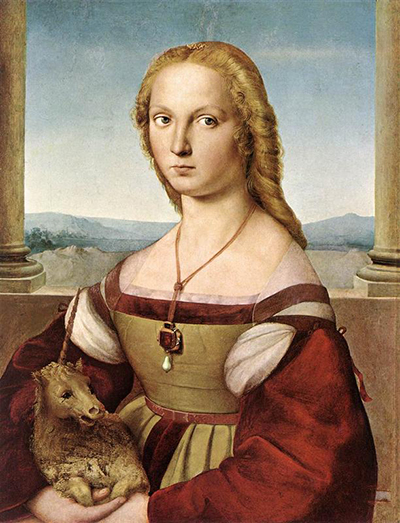Raphael's Portrait of a Lady with a Unicorn is believed to have been painted in 1505 or 1506, during the artist's Florentine period.
At this time he was beginning to explore a greater complexity and dynamism in his art, strongly influenced by the work of his contemporary Leonardo da Vinci. Many art historians even believe that this painting was inspired by the Mona Lisa, which Leonardo painted at roughly the same time. Both paintings feature similar composition, with matching poses and similar sizes and background styles. The painting depicts a young woman with blond hair and a piercing expression, sitting in front of a loggia, open to the landscape behind. In her arms is a small creature with a horn on its head - a unicorn.
At the time the painting was made, unicorns were a popular symbol of chastity, particularly associated with young women. The painting is extremely detailed and realistic, with a luminous quality that highlights the intensity of the subject's gaze and gives the work a compelling sense of immediacy. The medium is oil paint on panel, like much of Raphael's other work from the same period. This choice allowed him access to a richness of colour and detail unobtainable with tempera, his other common choice of pigment at around that time.
Portrait of a Lady with a Unicorn has a complex history. Centuries after its original creation, an unknown painter added new details - a Saint Catherine wheel, a palm frond and a cloak to cover the woman's bare shoulders - that obscured its subject and origins. For a long time, the painting was commonly misattributed to Pietro Perugino, who taught Raphael early in his career, and was believed to be a representation of the martyr Saint Catherine of Alexandria. Other artists were suggested as its creator, including Andrea del Sarto, Ridolfo del Ghirlandaio and Francesco Granacci.
The painting was restored in the 1930s and further analysis proved it to be the work of Raphael, as had been theorised not long before by Italian art historian Roberto Longhi. During this time, the painting was also transferred to canvas to ensure its preservation. The 17th-century additions were removed, and later radiography revealed the fact that Raphael himself had at some point made changes to the picture - the unicorn in the lady's arms was at one point a small dog instead, a symbol of fidelity.
The painting was most likely commissioned to celebrate a wedding, and probably depicts the bride. Opinions on her identity are divided, but some believe she was Laura Orsini della Rovere, who may have been the illegitimate daughter of Pope Alexander VI, and who was known for her blond hair. Others think the subject is Maddalena Strozzi, the wife of a wealthy merchant, who Raphael painted another picture of at around the same time. Today, the painting is on display in the Galleria Borghese in Rome, where it has been for much of its history.




